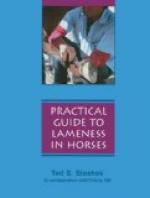Rupture of the suspensory ligament constitutes a condition which is, as a rule, hopeless, because of the impracticability of treating such cases.
The salient feature which characterizes any practical attempt at treatment of ruptured tendons or other portions of the inhibitory apparatus of the fetlock region, is to retain the phalanges in their normal position for a sufficient length of time that the approximated ends of ruptured tendons or ligaments may unite. The length of time required for this to occur, together with the difficulties encountered in confining the affected extremities in suitable braces or supportive appliances, precludes all possibility of this condition’s being practically amenable to treatment when the deep flexor tendon (perforans) and suspensory ligament are simultaneously ruptured. It does not follow, even so, that recovery does not succeed treatment in some of these unfavorable cases.
[Illustration: Fig. 27—A good style of shoe for bracing the fetlock where tenotomy has been performed, or in case of traumatic division of the flexor tendons. An invention of Dr. G.H. Roberts.]
Affected subjects are kept in slings as long as it seems necessary—until they learn to get up without deranging the braces worn.
Several styles of braces are in use and each has its objections; nevertheless some sort of support to the affected member is necessary and steel braces which are connected with shoes are usually employed.
The principal difficulty which attends the use of braces is pressure-necrosis of the skin which is caused by the constant and firm contact of the metal support. The practitioner’s ingenuity is taxed in every case to contrive practical means of padding the exposed parts in order to prevent or minimize necrosis from pressure. This is attempted—with more or less success—by frequent changing of bandages and the local application of such agents as alcohol or witch hazel. Needless to say, the skin must be kept perfectly clean and the dressings free from all irritating substances.
[Illustration: Fig. 28—Showing the Roberts brace in operation.]
The fact that tendons or ligaments which are ruptured, do not regenerate as readily as in cases where traumatic or surgical division occurs, must not be lost sight of, and prognosis is given in accordance.
Thecitis and Bursitis in the Fetlock Region.
Etiology and Occurrence.—Synovial distension of tendon sheaths and bursae in the region of the fetlock are caused by the same active agencies which produce this condition in other parts. The fetlock region is exposed to more frequent injury than is the carpus and as a consequence is more often affected. The same proportionate amount of irritation affects this part of the leg, owing to strains, as affect the carpus from a similar cause; and synovitis from this cause, is as frequent in one case as in the other. Therefore, it is a natural sequence that the tendon sheaths of the metacarpophalangeal region are frequently distended because of chronic synovitis and thecitis. These inflammations are usually non-infective in character.




